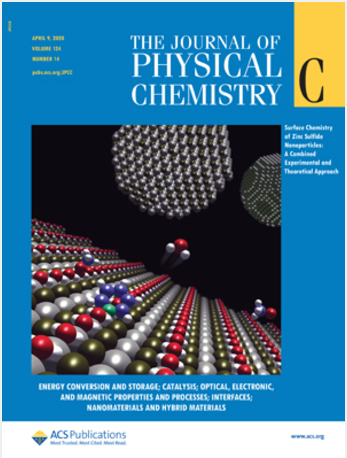了解结晶蒽衍生物中量子消隐时间与纠缠光子相互作用的相关性
IF 3.2
3区 化学
Q2 CHEMISTRY, PHYSICAL
引用次数: 0
摘要
量子到量子传导是量子系统之间的信息连贯交换,是量子信息科学(QIS)的基本要素。分子结构具有无与伦比的灵活性,可以定制对量子传导至关重要的特性,而分子合成则为自下而上地构建新型分子材料提供了机会。有机发色团固体中的单子裂变(SF)提供了一种实现光子-自旋量子转导的潜在方法,因为吸收单个光子会形成四个纠缠自旋,构成三重对态(TT)。我们已经证明,5,12-双(三环己基硅烷基乙炔基)-四碳(TCHS-tetracene)单晶体中的 SF 会产生长寿命的五重态 5(TT),这为 QIS 的多量子比特系统提供了一条很有前景的新途径。在这里,我们研究了经典光子和纠缠光子与 TCHS-tetracene 以及相关的 TIPS-tetracene 和 tetracene 的相互作用,以评估量子传导所需的分子特性。通过经典双光子吸收(TPA)实验,我们观察到 TCHS-tetracene 和 TIPS-tetracene 的 TPA 截面比四蒽更高。TCHS-tetracene 和 TIPS-tetracene 的纠缠 TPA 截面(分别为 6.914 × 10-19 和 5.057 × 10-19 cm2/molecule)比四蒽的纠缠 TPA 截面(5.146 × 10-20 cm2/molecule)大约一个数量级,这使得 TCHS-tetracene 和 TIPS-tetracene 成为利用 SF 演示光子-自旋转换的绝佳候选物质。我们还观察到,与所研究的蒽分子系统相比,TCHS-tetracene 的相干时间更长,这表明它适用于可能的 QIS 应用。本文章由计算机程序翻译,如有差异,请以英文原文为准。

Understanding the Correlation of the Quantum Dephasing Time and Entangled Photon Interaction in Crystalline Tetracene Derivatives
Quantum-to-quantum transduction is the coherent exchange of information between quantum systems, which is an essential element of quantum information science (QIS). Molecular architectures provide unmatched flexibility for tailoring the properties that are critical to quantum transduction, and molecular synthesis affords the opportunity to build novel molecular materials from the bottom-up. Singlet fission (SF) in organic chromophore solids provides a potential means of executing photon-to-spin quantum transduction because absorption of a single photon results in formation of four entangled spins that constitute a triplet pair state (TT). We have demonstrated that SF in single crystals of 5,12-bis(tricyclohexylsilylethynyl)-tetracene (TCHS-tetracene) produces a long-lived quintet state 5(TT) that provides a promising new route to multiqubit systems for QIS. Here, we investigate the interaction of classical and entangled photons with TCHS-tetracene as well as the related TIPS-tetracene and tetracene to assess the molecular properties required for quantum transduction. From the classical two-photon absorption (TPA) experiment, we observed that TCHS-tetracene and TIPS-tetracene have a higher TPA cross-section than tetracene. The entangled TPA cross-sections of TCHS-tetracene and TIPS-tetracene (6.914 × 10–19 and 5.057 × 10–19 cm2/molecule, respectively) are about an order of magnitude larger than that of tetracene (5.146 × 10–20 cm2/molecule), making TCHS-tetracene and TIPS-tetracene excellent candidates for demonstrating photon-to-spin transduction using SF. We also observed a longer coherence time for the TCHS-tetracene in comparison to the tetracene molecular systems investigated, which suggests its suitability for possible QIS applications.
求助全文
通过发布文献求助,成功后即可免费获取论文全文。
去求助
来源期刊

The Journal of Physical Chemistry C
化学-材料科学:综合
CiteScore
6.50
自引率
8.10%
发文量
2047
审稿时长
1.8 months
期刊介绍:
The Journal of Physical Chemistry A/B/C is devoted to reporting new and original experimental and theoretical basic research of interest to physical chemists, biophysical chemists, and chemical physicists.
 求助内容:
求助内容: 应助结果提醒方式:
应助结果提醒方式:


